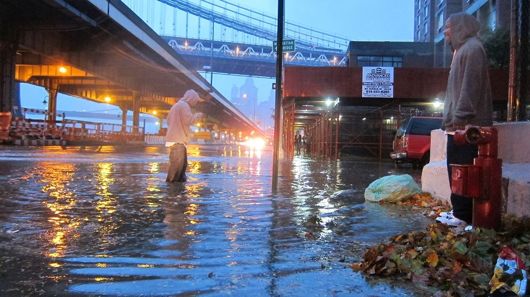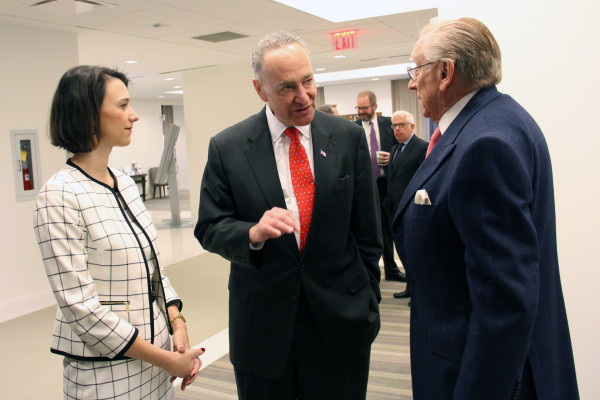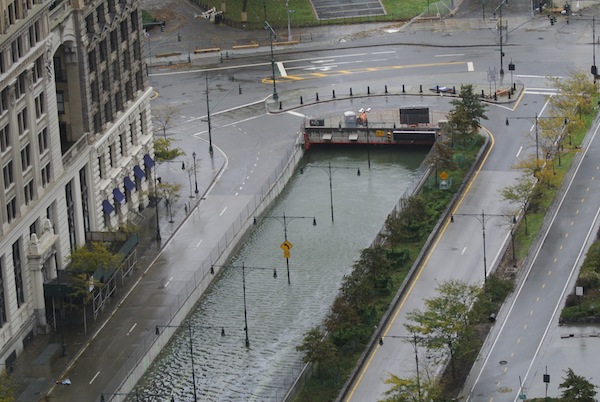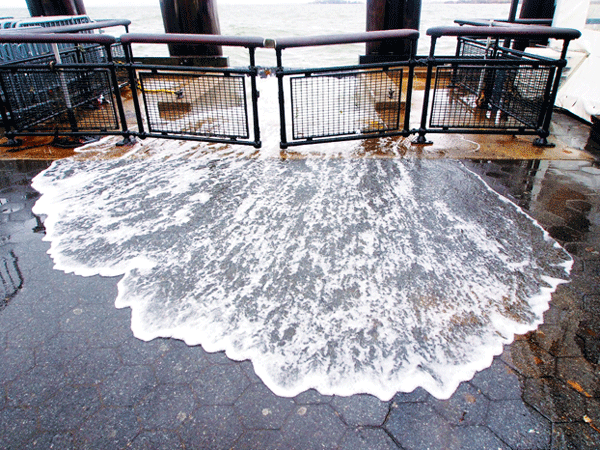
BY JOSH ROGERS | Death and destruction hit Lower Manhattan after Hurricane Sandy three years ago, but the area had been largely left out of storm protection plans until this month when the mayor and governor announced almost $15 million in funds for Downtown.
Local leaders pushing for more money celebrated the news, but they are still concerned that so little of the $4.21 billion post-Sandy federal package has been focused near Manhattan’s southern tip.
Catherine McVay Hughes, Community Board 1’s chairperson, estimated that up until this month, only about $1.5 million out of billions had been set aside for Manhattan resiliency plans south of Canal St. and the Brooklyn Bridge.
The city also ignored the area in the first phase of its federal application for some of the $1 billion “National Disaster Resilience Competion” grant money administered by HUD (the U.S. Dept. of Housing and Urban Development).
“C.B. 1 was disappointed that the significant unmet need in Lower Manhattan is not mentioned in the entire 60-page application,” Hughes said March 9 in testimony at a public hearing to discuss revising the city’s application.
That Downtown shortfall got a boost this week when U.S. Sen. Chuck Schumer said he was going to fight to make sure some of the grant money goes to Lower Manhattan.
“I’m here to commit to you that I’m going to make this the top of my list,” Schumer said Monday at a meeting of the Downtown-Lower Manhattan Association, according to the transcript of the event.
“Think about it – where is HUD going to get the most bang for their buck in resiliency if not Lower Manhattan,” Schumer added.

Jessica Lappin, president of the D-L.M.A., said she was thrilled to have such strong support, given the problem.
“Lower Manhattan’s needs are significant and remain underfunded,” said Lappin, who also runs the local Business Improvement District as president of the Downtown Alliance.
There were two Sandy-related deaths in Community Board 1 and some of the subway stops were among the last to reopen — effectively cutting Manhattan and the Bronx off from Brooklyn. Water flowed like a river through the Brooklyn-Battery Tunnel, and over to the east, water levels reached 7 feet at the South Street Seaport, damaging businesses and some homes.
The bulk of the city-directed funds have gone to housing, which the Downtown advocates recognize is an important need in hard hit areas elsewhere in the city.
But Lappin said the pie is big enough for some money Downtown.
“The city and the feds are focused on housing and we understand that, but I think there’s an opportunity for us to be successful,” she said.
It’ll be a good number of years before there will be major investments in C.B. 1 which is why some Downtowners were relieved to hear the joint city-state announcement earlier this month.
Battery Park
The city will spend $8 million for protection in historic Battery Park — likely berms jutting out from the park, the place where the Hudson and East rivers meet New York Harbor, officials announced on a Saturday, March 14.
“The Battery is down,” as the song goes, and the park in one of the city’s lowest-lying areas spots took in a deluge of water Oct. 29, 2012, the day Sandy reached New York.
The park work is not likely to begin until 2017, according to a city official and some Downtown leaders pushing for the project. The timeline is either praiseworthy or disappointing depending on whom you ask.
“For the city, that’s an expedited time frame,” said Lappin, who worked with other leaders to get the city to spend more in Lower Manhattan.
“Two years seems like an awfully long time for it to begin,” said Board 1’s Hughes, who had not heard directly about the timeline.

Hughes, who also led the state’s NY Rising group in Lower Manhattan, which recommended the Battery Park plan last year as part of post-Sandy planning, did say the new money is “a very welcome first step.”
Based on Rising’s recommendations, Gov. Andrew Cuomo had already committed $3.75 million for the park and similar Downtown projects.
With the city now taking care of the park, the state’s money will be added to a new $3 million city investment for a study covering Downtown’s east side from Montgomery St., down around the Battery, and the west side to the end of Battery Park City.
Big U or little i?
The idea is to come up with resiliency plans that are ready to go once more money is found, and to begin to plug a gaping funding hole in the much ballyhooed “Big U” plan.
The federal concept announced last year would form a U-shaped ring of flood protection around the lower half of Manhattan.
HUD is funding $335 million of the project’s first phase from the Lower East Side’s Montgomery St. up to E. 23rd St.
“It’s not a Big U — it’s more like a little ‘i’ right now,” Patrick Ryan of the Mayor’s Office of Recovery and Resiliency said at a Community Board 1 meeting March 9, five days prior to the mayor’s announcement.
Hughes, who calls the first section a “little squiggle,” said while she’s happy there will be major investments north of Montgomery St. (2017 is also the target to start construction there), she’s also concerned Lower Manhattan would be even more vulnerable to floods once the protections are in place up to the north.
“If you build something north of Montgomery St. you need to study what will be the impact in Lower Manhattan,” she said. “Better than that would be a plan for protection further Downtown.”
The decision to start building to the north amounted to sacrificing protection in large housing complexes like LaGuardia and Smith Houses in favor of the even larger Stuyvesant Town.
“The hardest hit are the ones that will be the least protected,” Aixa Torres, president of the tenant association at Smith, told Downtown Express a few months ago. “What happens to the rest of us?”
“The pace and funding shortage are certainly still serious concerns,” said State Sen. Daniel Squadron.
Another Downtown leader who has been pressing the city to focus more Downtown, Councilmember Margaret Chin, said that because of the long wait for protection, she’s hoping the new study might produce “some short-term things the city can do in terms of resiliency.”
Mayor Bill de Blasio, in announcing the city money said in a statement that “Lower Manhattan residents and businesses know too well just how devastating Sandy was to this community,” adding that the Battery Park project and study would help “ensure that Lower Manhattan is better prepared next time extreme weather hits.”
How long a wait?
In related news, President Barack Obama put $1 million in his proposed budget for the Army Corps of Engineers to study long-range solutions for New York and New Jersey.
If passed, the money would require matching funds from both states and the city, but the Corps has been working closely with all three and officials said at C.B. 1’s Planning Committee meeting March 9 that they were not concerned that there would be a holdup.
And even though Congress has been trying to slash the budget, Paul Tumminello, the Army Corps’ chief of civil works programs for the New York district, said there was a much greater chance the $1 million study would be increased rather than cut or reduced.
C.B. 1’s Bob Schneck pressed for the best case scenario, assuming no hiccups in Congress, and matching funds for the study. How long would it take to start building something more in Lower Manhattan?
“It’s probably about a decade,” Tumminello told him.


















